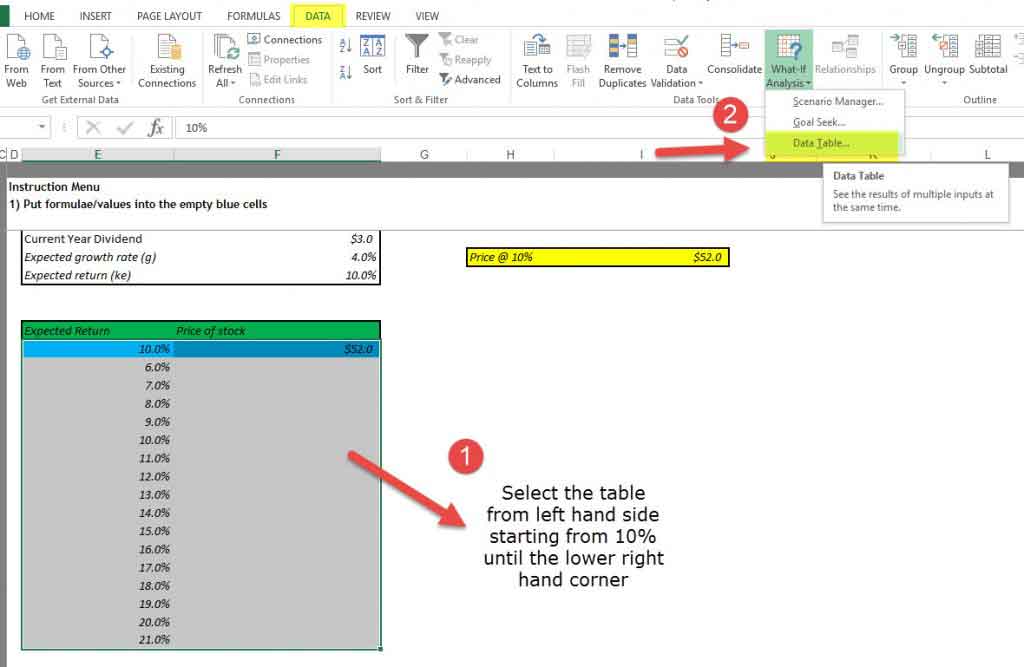

Leave a few empty rows and columns on either side of the values. Type the list of values that you want to substitute in the input cell-either down one column or across one row. Any formula in a one-variable data table must refer to only one input cell. To learn more, see the section Speed up calculation in a worksheet that contains data tables.Ī one-variable data table contain its input values either in a single column (column-oriented), or across a row (row-oriented). To speed up calculation of a worksheet that contains a data table, you can change the Calculation options to automatically recalculate the worksheet but not the data tables. Whenever a worksheet recalculates, any data tables will also recalculate-even if there has been no change to the data. In the following illustration, cell C2 contains the payment formula, =PMT(B3/12,B4,-B5), which uses two input cells, B3 and B4. For example, you can use a two-variable data table to see how different combinations of interest rates and loan terms will affect a monthly mortgage payment. Use a two-variable data table to see how different values of two variables in one formula will change the results of that formula. In the following illustration, cell D2 contains the payment formula, =PMT(B3/12,B4,-B5), which refers to the input cell B3. You enter the variable values in one column or row, and the outcomes are displayed in an adjacent column or row. For example, you can use a one-variable data table to see how different interest rates affect a monthly mortgage payment by using the PMT function. Use a one-variable data table if you want to see how different values of one variable in one or more formulas will change the results of those formulas. Learn more in the article, Introduction to What-If Analysis.Ĭreate either one-variable or two-variable data tables, depending on the number of variables and formulas that you need to test. A scenario can have a maximum of 32 different values, but you can create as many scenarios as you want. Although it is limited to only one or two variables (one for the row input cell and one for the column input cell), a data table can include as many different variable values as you want. If you want to analyze more than two variables, you should instead use scenarios. Because you focus on only one or two variables, results are easy to read and share in tabular form.Ī data table cannot accommodate more than two variables. Using data tables makes it easy to examine a range of possibilities at a glance. Unlike scenarios, data tables show you all the outcomes in one table on one worksheet.

Like scenarios, data tables help you explore a set of possible outcomes. Goal-seek is distinctly different, it uses a single result and calculates possible input values that would produce that result. Scenarios and data tables use sets of input values to calculates possible results. There are three types of what-if analysis tools in Excel: scenarios, data tables, and goal-seek. For more information, see Excel What-If Data Tables: Faster calculation with VBA. It is not advisable to switch between Table and regular cells and back again.ĭownload the sample Excel file attached to this tutorial so you can try this out in Excel.Note: You can perform faster calculations with data tables and Visual Basic for Applications (VBA). If you convert a table back to a range and then convert it again to a table, any formulas you had in the table will be stuck using regular cell references and the Totals row, if it existed, will be considered a normal row at first. To remove the table's appearance quickly, highlight the table, go to the Home tab and look all the way to the right and click the Clear button and then Clear Formats If you click in the % of Goal column, all the formulas have been converted to use regular cell references instead of structured references.Īlso, the table features are no longer readily available. The format looks the same but the cells are no longer an actual "table" within Excel. Click Yes in the small window that appears.Go to the Design tab that should appear when you select a table.Oddly enough, this isn't as straightforward as it seems like it should be.
#Excel mac formula for sensitivity table how to#
This removes any automated table features and I'll show you how to quickly remove the visual formatting as well. Convert a table back into a regular set of cells.


 0 kommentar(er)
0 kommentar(er)
